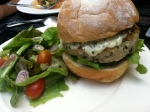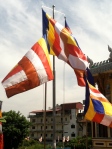- Typical building style in Phnom Penh.
- The skyline of the capital city, which really only includes about half a dozen buildings over six or seven stories.
- The gatehouse to the Royal Palace that sits along the Mekong River.
- The tuk-tuks or motorcycle powered carriages we took all over Phnom Penh and Angkor Wat.
- A delicious chicken burger with pesto mayonaise that I had at the Friends Restaurant , a NGO that takes in children living on the street and trains them how to be chefs, waiters and restaurant owners so they can earn a decent living. The organization also runs a school next door.
- The international flag of buddhism that is found all over Cambodia and Viet Nam. These flags were flying over a pagoda in Phnom Penh.
- The Royal Palace seen through the gate. The palace was only open to the public between 2 and 5 PM and women were required to cover their knees and shoulders. Because of the restrictions we never made it inside.
- The Cambodian Independence Monument is an example of classic Khmer architecture. The figures covering the structure are nagas or sea serpents, which represent the sea god are found all over Cambodia.
Sorry for the delay everyone. It has been a crazy last week traveling around Southern Vietnam and all over Cambodia, but I have not forgotten about you and the blog! I have pictures, videos, and plenty of news ( or khabar to continue with the alliteration theme) and stories to share.
My trip to Cambodia started a week agotoday. We were meeting as a group in the backpacking area of District 1 (the central part of the city) to catch a bus to Phnom Penh, the capital of Cambodia. However, I had to leave a bit early to head to the doctor and get an ongoing throat issue cleared up. (Don’t worry I’m fine now.) After my appointment I walked out of the modern office building that the clinic is located in and began searching for a taxi. Since this was the third day of Tet the streets were deserted and there were not that many options from which to chose.
At the end of the street I found a man lounging on his motorbike though and he asked, “Ride!” Since the streets were deserted, the driver looked respectable and had a helmet and I had the address I was going to written down on a piece of paper I decided to give a motortaxi ride or xe ohm a shot. As with a lot of things in Vietnam and Cambodia, we had to haggle about the price first which I was agreed upon at 30,000 dong or ba moui dong. The drive was nice and scenic, going past many of the city’s main sites. I had luckily picked a good driver who wentslow and I managed to enjoy the ride.
When we got to the bus station (which is really just a street filled with buses), I got off and tried to pay the driver but he insisted that we had really agreed upon 40,000 dong. I still am not sure if this is because 3 and 4 sound similar in Vietnamese, being ba and bone, or if he was just taking advantage of an obvious newcomer to the country. Unfortunately he was holding my bag hostage and I wasn’t in much of a position to argue. Also, the different of 10,000 dong equals about 50 cents so I ended up giving in rather quickly. Afterwards, I managed to find the other Americans and we boarded the bus for Cambodia.
The ride was rather uneventful. It started with the playing of calming music and video-recorded scenes of Vietnamese wildlife (a staple of travel no matter what type of transportation you are using here) and ended with an intense and incredibly long Chinese kung-fu movie. At the Cambodian-Vietnamese boarder we had to disembark three times, once on the Vietnamese side, again on the Cambodian side to get out visas and immigration paper work figured out, and finally to eat lunch at a rather questionable Cambodian road-side restaurant. (I’m still amazed that the only thing that has given me food poisoning up until this point is a Ho Chi Minh City Pizza Hut.) For being one of the poorest countries in theworld, Cambodia has a pretty elaborate immigration system with fingerprint scanner, digital cameras and rapid medical checks.
When we got to Phnom Penh after 6 hours on the bus I was struck by how different it is from Ho Chi Minh City. The streets are far less crowded with maybe only a third the traffic of Saigon. Instead of blocks that house dozens of smaller apartments, stores and pagodas all stacked on top of each other, each city block is taken up by one large, Soviet-looking concrete building. A few French colonial buildings remained but they were far and few between. The most noticeable buildings in the area were definitely the Buddhist pagodas which all had large courtyards and tall red and gold roofs. On some of the larger boulevards there are large monuments that celebrate Cambodian independence, the monarchy and “friendship” with Viet Nam. (The two countries have a bit of a conflicted history.)
Overall, the city definitely had some beauty, especially in the large public parks along the rivers and near the King’s palace estate in the downtown area, but it was simultaneously obvious how depressed Cambodia is. Phnom Penh and the country as a whole is not developing nearly as fast as Viet Nam. The buildings are of a poorer quality, there are far fewer businesses, more people sleep on the street and beggars can be found on every corner that also has tourists. I had wanted to mentally separate the current country I was visiting from the long history of civil war and genocide that usually come up when people think of this place, but it was incredibly difficult to do so. It was clear that Khmer people are just recently emerging from a long struggle and that the outside world is just beginning to take notice.








